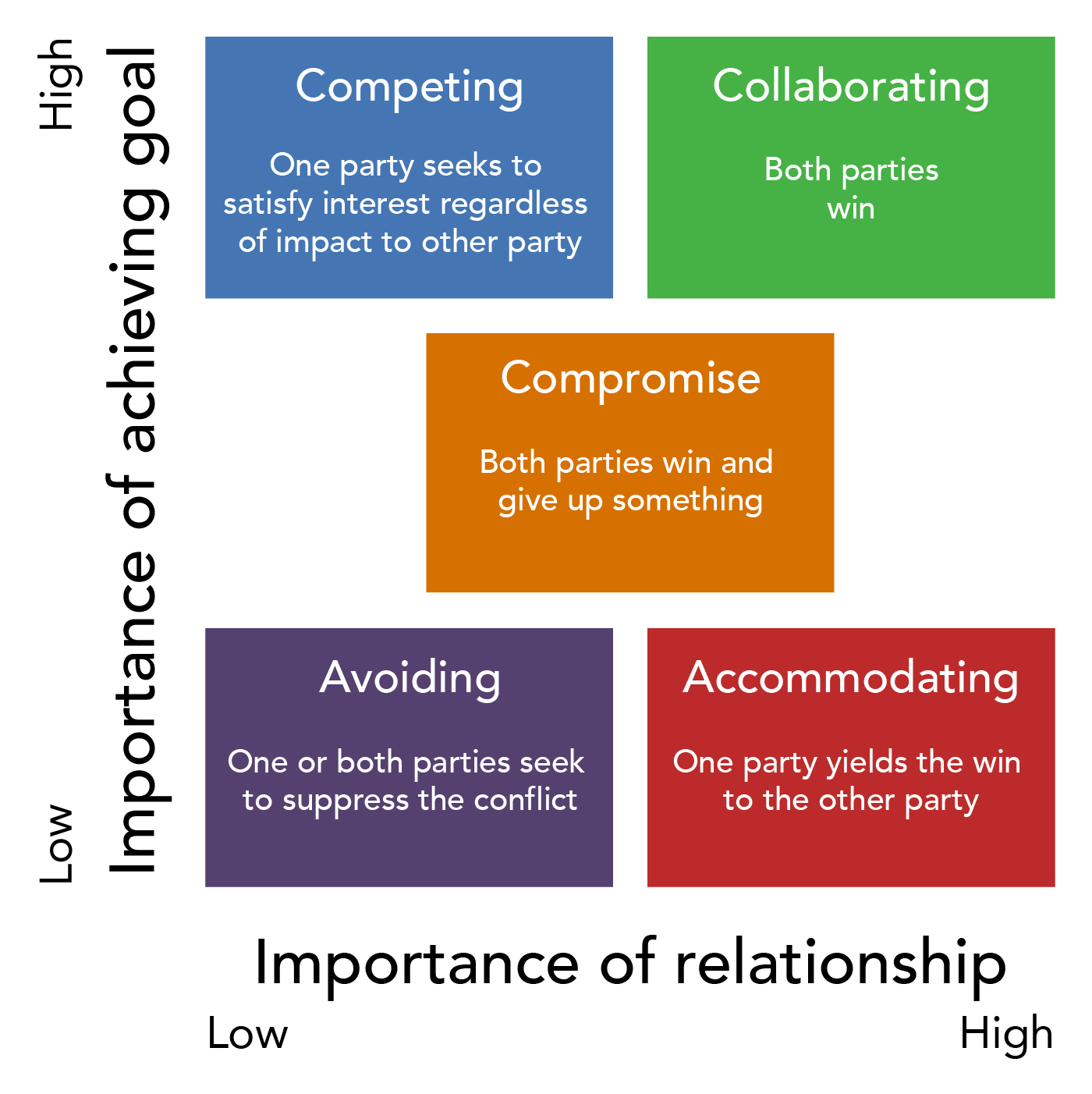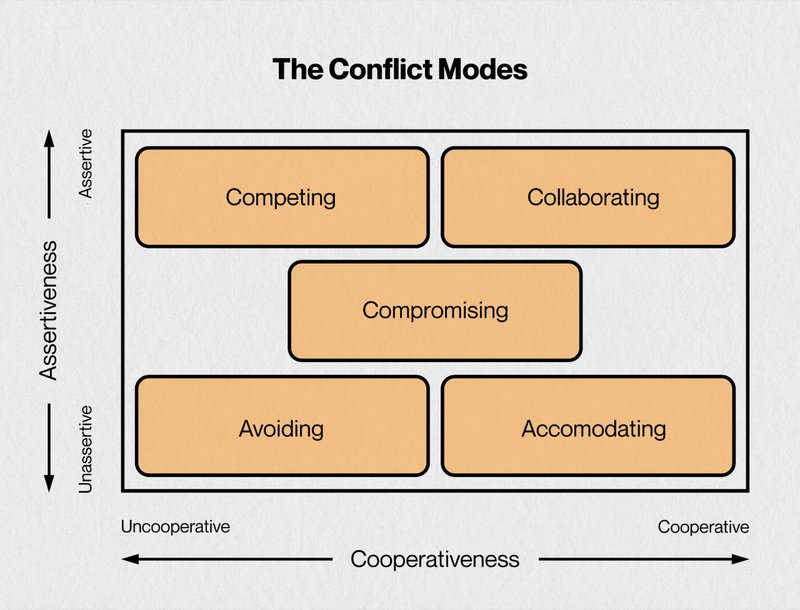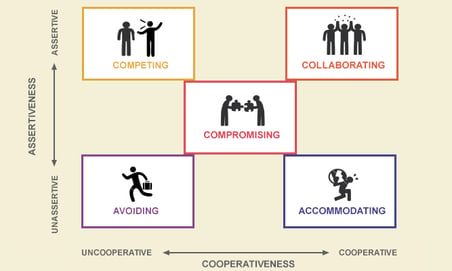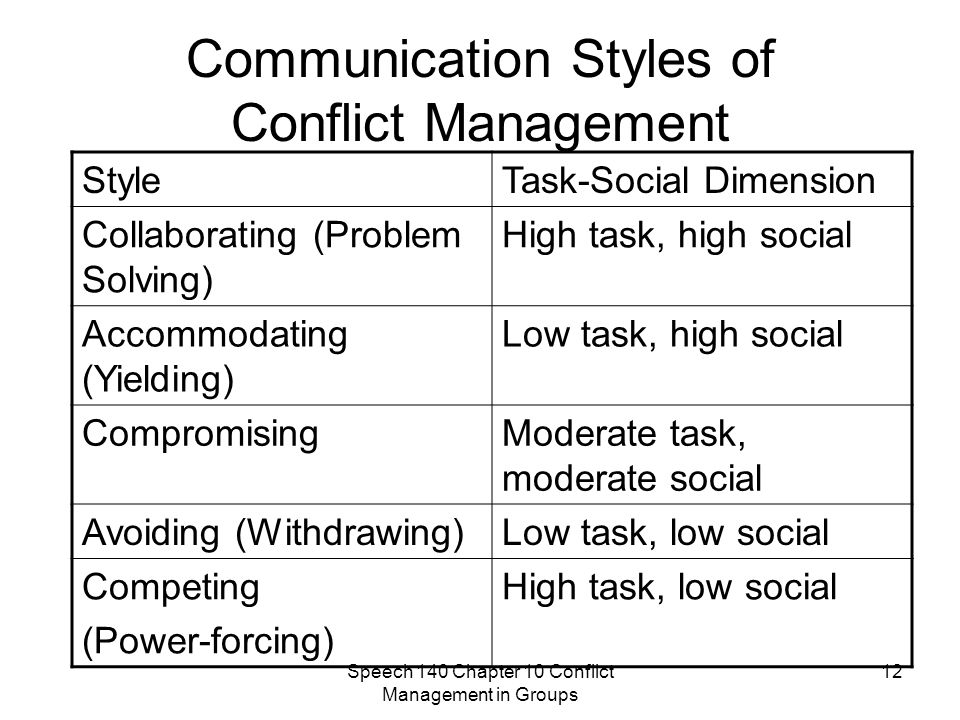May provide a quick resolution to a conflict. The competing power-forcing conflict management style has the greatest potential for destructive conflict to occur.

What Is Conflict Management Definition Styles Strategies Video Lesson Transcript Study Com
The other type of conflict is called relationship.

. Competing power-forcing style of conflict management in groups 1 places primary emphasis on the task dimension and little focus on the social dimension of groups and. The power-forcing style of conflict management. May negatively affect your relationship with the opponent in the long run.
How to choose a conflict management style. The competing power-forcing conflict management style should always be avoided. 1 places primary emphasis on the task dimension and little focus on the social dimension of groups and 2 should be the style of last resort in most situations.
You push the problem by sitting on it and taking no decision. There are two different types of conflict. It is found in virtually all businesses and is the power associated with CEOs managers and other authority figures.
Choosing a conflict management style depends on the desired outcome the relationships involved and the timeframe. This tactic can often be perceived as an abuse of power or authority. Accommodating is often the conflict management style of the less powerful.
Most conflict management styles will work for this with the exception of competition. Legitimate power isnt always associated with a specific role. Conflict Resolution on the Jobsite.
Studies suggest that people usually prefer one or two styles to others but there are several benefits of each. Legitimate power is the power granted by holding a position or role. Ø Unpopular action must be taken on important issues Ø Commitment by others is not critical Ø Maintaining.
The power-forcing style of conflict management places primary emphasis on the task dimension and little focus on the social dimension of groups Constructive conflicts differs from destructive conflicts because constructive conflict. Problem Solving The visual below shows how these styles compare to Coveys six paradigms of human interaction. One of it is task conflict and focuses on the ways to resolve problems.
As a last resort to resolve a long-standing conflict. A creative solution is critical. The forcing style of conflict management presents the highest risk of relationship conflict and it should never be used to manage conflicts in organizations.
For example rather than saying GiGi has horrible ideas that are going to bring down the whole team but she refuses to collaborate you might say to the boss The team is. Its not always an effective strategy but in certain situations you may feel you have no choice. According to the Thomas-Kilmann Conflict Mode Instrument TKI there are five conflict management styles.
The Conflict Management Styles we explore here are based on the Thomas-Kilmann Model. Increases self-esteem and draws respect when firm resistance or actions were the response to aggression or hostility. Forcing - using formal authority or other power that you possess to satisfy your concerns without regard to the concerns of the party that you are in conflict with.
People need to work through their emotions surrounding the conflict. Accommodating - allowing the other party to satisfy their concerns while neglecting your own. Relationships take on a lower priority.
In the avoiding conflict style you avoid conflict and confrontation until the situation resolves itself. It can also arise from a code or standard which influences behavior and choices. Force as a conflict management strategy entails taking advantage of ones professional position or other type of authority to coerce or intimidate others and ultimately get what one wants.
You should use the forcing conflict management style when. This style is about simply putting the other parties needs before ones own. A manager skilled in conflict resolution should be able to take a birds-eye view of the conflict and apply the conflict management style that is called for in that specific situation.
Lets look at each conflict management style in detail. However knowing when and how to utilize these different approaches effectively can help you navigate. Avoiding is always an ineffective conflict management style because it ignores the conflict instead of confronting it directly.
Possible advantages of forcing. Use the following steps to select the appropriate conflict management style. Some caveats of forcing.
Sharks do not hesitate to use aggressive behavior to resolve conflicts. Stages of the process of forgiveness include a hating b hurting c healing d coming together e all of the above. Conflict management styles such as passive aggressive style forcing style avoiding style accommodating style compromising style and collaborating style.
Accommodating avoiding collaborating competing and compromising. A True b False. Forcing Conflict Style contd Advantages Ø Decisions may be better if the forcer is right Disadvantages Ø Overuse leads to hostility and resentment toward its user Ø Forcers tend to have poor human relations Appropriately used when.
Conflict Management Styles The Competing Shark Sharks use a forcing or competing conflict management style. If you cant solve it without intervention request help as neutrally as possible. When choosing a style each individual has one or two that they prefer over others.
You need to arrive at a workable solution under time pressure. Quick decisive action is important. You allow them to win and get their way.
The avoiding conflict style is one of five styles of conflict management. Sharks are highly goal-oriented. Yet there are situations in which using force is necessary to achieve the desired results.

Pdf Conflict Management Styles Historical Evolution Perspectives And Rationalisation

5 Effective Conflict Management Strategies In 2022 The Blueprint

Styles Of Conflict Resolution Competing Avoidingaccommodating Collaborating Compromising Assertive Unassertive Party S Desire To Satisfy Own Concerns Uncooperativecooperative Ppt Download

Styles Of Conflict Resolution Competing Avoidingaccommodating Collaborating Compromising Assertive Unassertive Party S Desire To Satisfy Own Concerns Uncooperativecooperative Ppt Download

5 Most Effective Conflict Management Styles When To Use Each One

Conflict Management Styles Organizational Behavior And Human Relations

In Mixed Company Chapter Ten Ppt Download

The Relationship Between Power Bases And Conflict Management Styles Of Indonesia S Formal Leaders Semantic Scholar
0 comments
Post a Comment